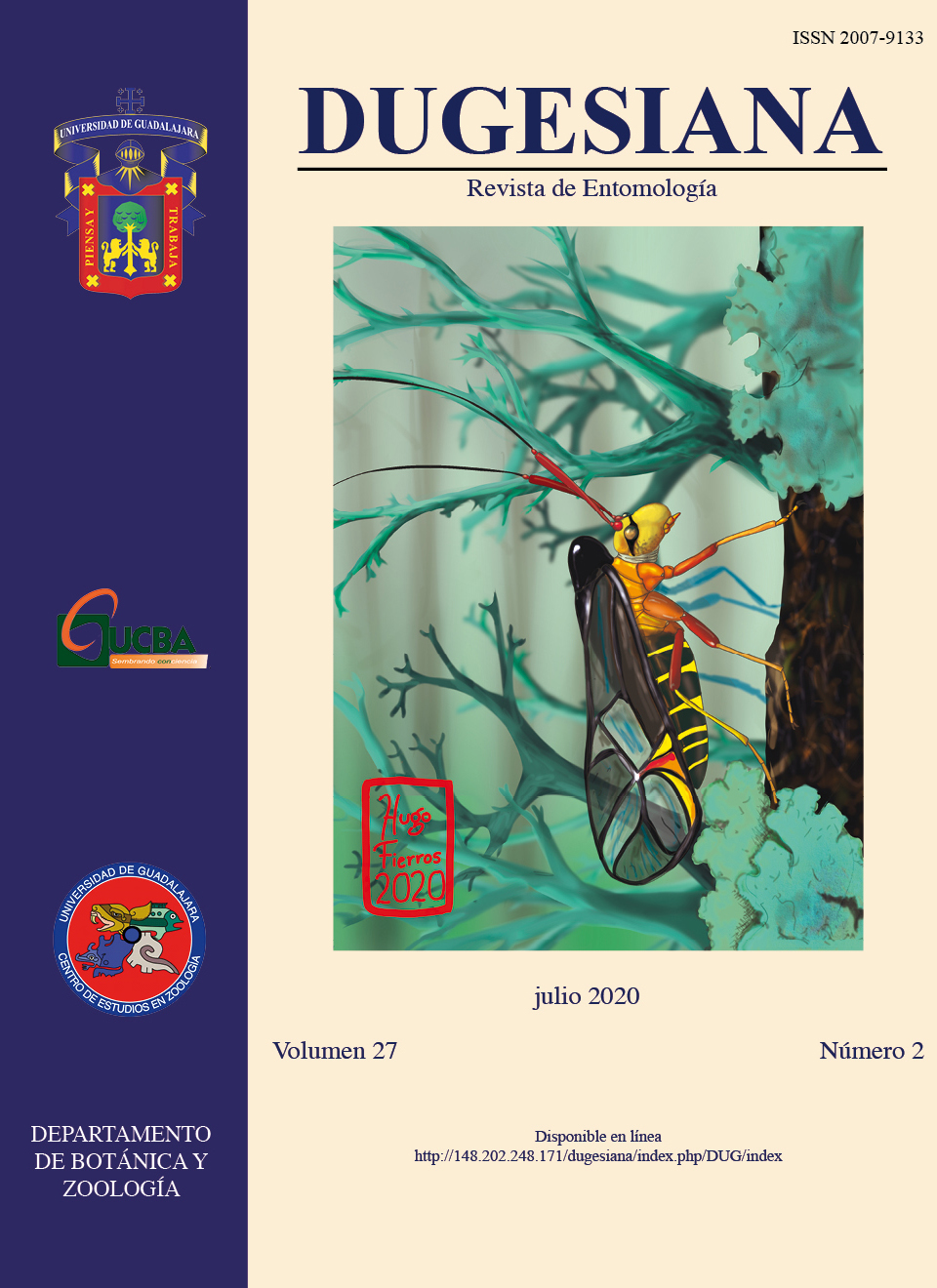Courtship and mating behavior in four Pachytroctid species (Psocodea: ‘Psocoptera’: Troctomorpha: Nanopsocetae: Pachytroctidae)
DOI:
https://doi.org/10.32870/dugesiana.v27i2.7104Palabras clave:
courtship, Pachytroctidae, mating behavior matingResumen
Courtship and mating behavior were investigated in four species, representing three different genera, in the family Pachytroctidae. All exhibited a lengthy courtship in the male-above position followed by brief copulation in the female-above position with both facing in the same direction. This courtship behavior has not previously been observed in ‘Psocoptera’ and may be unique to Pachytroctidae. In three of the species in this study, the spermatophore remnant protruded from the tip of the male’s abdomen after copulation, and was immediately deposited on the surface of the experimental enclosure. Differences in courtship behavior of the two closely related and sympatric Tapinella species, described in this report, may represent reproductive isolating mechanisms. Under experimental conditions, we observed a male of each Tapinella species mount, court, and attempt to mate with a virgin female of the other species. In each case the female rejected the male and failed to mate. Implications relative to these behaviors are discussed. DOI links to videos are provided for easy access.Citas
Betz, B. W. 1983. The biology of Trichadenotecnum alexanderae Sommerman (Psocoptera: Psocidae) III Analysis of mating behavior. Psyche 90(1): 97-117.
Broadhead, E. 1961. The biology of Psoquilla marginepunctata (Hagen) (Corrodentia,Trogiidae). Transactions of the Society for British Entomology 14(10): 223-236.
Broadhead, E. 1952. A comparative study of the mating behavior of eight Liposcelis species. Transactions of the Ninth International Congress of Entomology 1: 381-383.
Duelli, P. and J. B. Johnson. 1981. Behavioral origin of tremulation, and possible stridulation, in green lacewings (Neuroptera: Chrysopidae). Psyche 88: 375-381.
Engelmann, F. 1970. The Physiology of Insect Reproduction, International Series of Monographs in Pure an Applied Biology, Vol. 44. Pergamon Press, Oxford, New York, Toronto, Sydney, Braunschweig.
Huber, B. A. 2010. Mating positions and the evolution of asymmetric insect genitalia. Genetica 138: 19-25.
Mann, T. 1984. Spermatophores, Zoophysiology, Vol. 15. Springer-Verlag, Berlin, Heidelberg, New York, Tokyo.
Mockford, E. L. 1993. North American Psocoptera, Flora & Fauna Handbook No. 10. Sandhill Crane Press, Inc. Gainesville, Florida.
Mockford, E. L. and J. J. Wynne. 2013. Genus Cyptophania Banks (Psocoptera: Lepidopsocidae): unique features, augmented description of the generotype, and descriptions of three new species. Zootaxa 3702(5): 437-449.
Mockford, E. L. and D. W. Young. 2019. Peritroctes bengalensis Thornton & Wong in Texas, first western hemisphere records and first description of the male, macropterous female, and egg (Psocodea: ‘Psocoptera’: Pachytroctidae). Entomological News 128(3): 233-242.
Sommerman, K. M. 1944. Bionomics of Amapsocus amabilis (Walsh) (Corrodentia: Psocidae). Annals Entomological Society of America 37: 359-364.
Sommerman, K. M. 1956. Two new species of Rhyopsocus (Psocoptera) from the U. S. A., with notes on the bionomics of one household species. Journal of the Washington Academy of Science. 46: 145-149.
Thornton, I. W. B. and S. K. Wong. 1966. Some Psocoptera from West Bengal, India. Transactions of the Royal Entomological Society of London 118(1): 1-21.
Wearing-Wilde, J. 1996. Mate choice and competition in the barklouse Lepinotus patruelis (Psocoptera: Trogiidae): The effect of diet quality and sex ratio. Journal of Insect Behavior 9(4): 599-612.
Descargas
Archivos adicionales
Publicado
Número
Sección
Licencia
1. Política propuesta para revistas que ofrecen acceso abierto
Aquellos autores/as que tengan publicaciones con esta revista, aceptan los términos siguientes:- Los autores/as conservarán sus derechos de autor y garantizarán a la revista el derecho de primera publicación de su obra, el cuál estará simultáneamente sujeto a la Licencia de reconocimiento de Creative Commons que permite a terceros compartir la obra siempre que se indique su autor y su primera publicación esta revista.
- Los autores/as podrán adoptar otros acuerdos de licencia no exclusiva de distribución de la versión de la obra publicada (p. ej.: depositarla en un archivo telemático institucional o publicarla en un volumen monográfico) siempre que se indique la publicación inicial en esta revista.
- Se permite y recomienda a los autores/as difundir su obra a través de Internet (p. ej.: en archivos telemáticos institucionales o en su página web) antes y durante el proceso de envío, lo cual puede producir intercambios interesantes y aumentar las citas de la obra publicada. (Véase El efecto del acceso abierto).
2. Política propuesta para revistas que ofrecen acceso abierto diferido
Aquellos autores/as que tengan publicaciones con esta revista, aceptan los términos siguientes:- Los autores/as conservarán sus derechos de autor y garantizarán a la revista el derecho de primera publicación de su obra [ESPECIFICAR PERIODO DE TIEMPO], el cuál estará simultáneamente sujeto a la Licencia de reconocimiento de Creative Commons que permite a terceros compartir la obra siempre que se indique su autor y su primera publicación esta revista.
- Los autores/as podrán adoptar otros acuerdos de licencia no exclusiva de distribución de la versión de la obra publicada (p. ej.: depositarla en un archivo telemático institucional o publicarla en un volumen monográfico) siempre que se indique la publicación inicial en esta revista.
- Se permite y recomienda a los autores/as difundir su obra a través de Internet (p. ej.: en archivos telemáticos institucionales o en su página web) antes y durante el proceso de envío, lo cual puede producir intercambios interesantes y aumentar las citas de la obra publicada. (Véase El efecto del acceso abierto).




